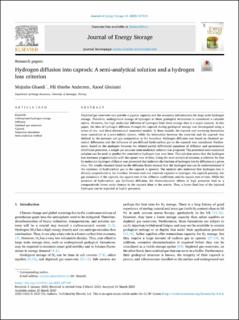| dc.contributor.author | Ghaedi, Mojtaba | |
| dc.contributor.author | Andersen, Pål Østebø | |
| dc.contributor.author | Gholami, Raoof | |
| dc.date.accessioned | 2023-12-01T08:30:58Z | |
| dc.date.available | 2023-12-01T08:30:58Z | |
| dc.date.created | 2023-03-23T20:48:31Z | |
| dc.date.issued | 2023 | |
| dc.identifier.citation | Ghaedi, M., Andersen, P. Ø., & Gholami, R. (2023). Hydrogen diffusion into caprock: A semi-analytical solution and a hydrogen loss criterion. Journal of Energy Storage, 64, 107134. | en_US |
| dc.identifier.issn | 2352-152X | |
| dc.identifier.uri | https://hdl.handle.net/11250/3105539 | |
| dc.description.abstract | Depleted gas reservoirs can provide a gigaton capacity and the necessary infrastructure for large scale hydrogen storage. Therefore, underground storage of hydrogen in these geological formations is considered a valuable option. However, the high molecular diffusion of hydrogen from these storage sites is a major concern. In this paper, the idea of hydrogen diffusion through the caprock during geological storage was investigated using a series of one- and three-dimensional numerical models. In these models, the caprock and overlying formations were considered as a semi-infinite system, while the interaction between the reservoir and the caprock was defined by the pressure and gas composition at the boundary. Hydrogen diffusion was based on chemical potential differences and the influence of pre-diffused hydrocarbon gas in the caprock was considered. Furthermore, based on the analogies between the related partial differential equations of diffusion and spontaneous imbibition processes, a simple yet accurate semi-analytical solution was proposed. The presented semi-analytical solution can be used to predict the cumulative hydrogen loss over time. This solution states that the hydrogen loss increases proportionally with the square root of time. Using the semi-analytical solution, a criterion for loss by molecular hydrogen diffusion was presented that indicates the fraction of hydrogen lost by diffusion at a given time. The results obtained based on the diffusion fluxes showed that the hydrogen loss can be underestimated if the existence of hydrocarbon gas in the caprock is ignored. The analysis also indicated that hydrogen loss is directly proportional to the interface between rock and reservoir exposed to hydrogen, the caprock porosity, the gas saturation of the caprock, the square root of the diffusion coefficient, and the square root of time. While the presence of hydrocarbon gas facilitates diffusion, the thermodynamic effects at high pressures lead to a comparatively lower molar density in the caprock than in the matrix. Thus, a lower final loss of the injected hydrogen can be expected at higher pressures. | en_US |
| dc.language.iso | eng | en_US |
| dc.publisher | Elsevier | en_US |
| dc.rights | Navngivelse 4.0 Internasjonal | * |
| dc.rights | Navngivelse 4.0 Internasjonal | * |
| dc.rights.uri | http://creativecommons.org/licenses/by/4.0/deed.no | * |
| dc.title | Hydrogen diffusion into caprock: A semi-analytical solution and a hydrogen loss criterion | en_US |
| dc.type | Peer reviewed | en_US |
| dc.type | Journal article | en_US |
| dc.description.version | publishedVersion | en_US |
| dc.rights.holder | © The Author(s) 2023 | en_US |
| dc.subject.nsi | VDP::Matematikk og Naturvitenskap: 400 | en_US |
| dc.source.volume | 64 | en_US |
| dc.source.journal | Journal of Energy Storage | en_US |
| dc.identifier.doi | 10.1016/j.est.2023.107134 | |
| dc.identifier.cristin | 2136578 | |
| dc.relation.project | Norges forskningsråd: 331644 | en_US |
| cristin.ispublished | true | |
| cristin.fulltext | postprint | |
| cristin.fulltext | original | |
| cristin.qualitycode | 1 | |

